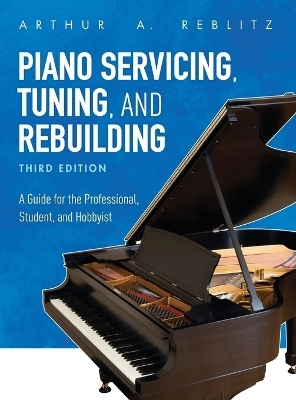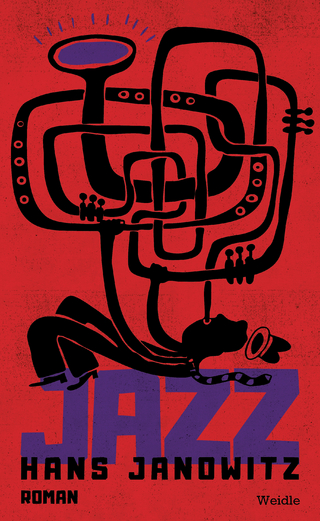
Piano Servicing, Tuning, and Rebuilding
Rowman & Littlefield (Verlag)
978-1-5381-1443-8 (ISBN)
All the information needed for restoring and maintaining pianos is contained in this clearly written volume. Arthur A. Reblitz provides the ultimate reference book and instruction manual for both the professional and the amateur.
Professional piano technicians rely on Piano Servicing in their daily work, yet its instructions and the hundreds of clear drawings and photographs are so easily understood that any person handy with tools can quickly grasp the fundamentals of piano servicing and rebuilding work. At least twenty-five schools where piano servicing is taught use this as a text.
Having sold more than 45,000 copies of the first edition, Vestal Press in pleased to have played a role in helping technicians and hobbyists rebuild, maintain, and tune untold numbers of pianos and is especially proud of the book's endorsement by the House of Steinway. This greatly enhanced and enlarged second edition has new material to benefit owners of the earlier edition.
Arthur A. Reblitz is a registered piano technician and member of the Piano Technician’s Guild. He is recognized as one of the world’s leading authorities on restoration of orchestrions, coin pianos, and reproducing pianos. His shop, Reblitz Restorations, Inc., has restored automatic musical instruments for many of the world’s foremost public and private museums and collections. Reblitz is known worldwide as one of the finest arrangers of music for these instruments. Other books by Reblitz include Player Piano Servicing and Rebuuilding, Treasures of Mechanical Music (with Q. David Bowers), and The Mills Violano-Virtuoso (with Michael L. Kitner). He has written articles for The Guidebook of Automatic Music Instruments, Encyclopedia of Automatic Musical Instruments, the News Bulletin of the Musical Box Society International, the Bulletin of the Automatic Musical Instrument Collector’s Association, and The Coin Slot magazine. He is the 1982 recipient of the Literary Award of the Musical Box Society for Outstanding Literary Contributions to the Field of Automatic Music and the 1993 recipient of the Leo Ornstein Literary Award of the Automatic Musical Instrument Collectors’ Association.
Chapter One — Introduction to the Piano: Styles, Shapes, and Sizes
Antique Pianos
Victorian Pianos
Twentieth-Century Pianos and Beyond
Player Pianos
Contemporary Trends
Electronic Pianos
Chapter Two — Inside Information: The Names of the Parts and How They Work
Major Parts
Cushioning Materials in Pianos
The Soundboard and Bridges
The Pinblock
The Plate
Downbearing
The Tuning Pins
The Strings
Stringing Arrangements
The Keybed and Keyframe
The Keys
The Keytops
The Hammers
Traditional Wooden Action Parts vs. Composite Parts
The Vertical Action
How the Upright Action Works
The Dampers
Upright Action Variations
The Console Action
The Drop Action
Vertical Piano Pedals
The Grand Action
How the Grand Action Works
The Grand Hammer Rest or Rail
Grand Pedals
Grand Action Variations
The Square Piano
How the Square Piano Action Works
Chapter Three — Evaluating an Old Piano: Is It Worth Buying or Repairing?
Selecting a Type and Size
Recognizing Quality
The Importance of Age
Gray Market Pianos
Evaluating the Condition
Player Pianos and Empty Player Pianos
Mirror Pianos
Where to Find a Used Piano
Myths Versus Reality
Summary
Chapter Four — Cleaning and Minor Repairs: Fixing Worn and Broken Parts
Safety First!
Basics of Tools and Woodworking
Glue Joints
Types of Glue Used in Piano Repair
Lubricants Used in Pianos
Modern Lubricants
Traditional Lubricants
Repairing Loose Screw Holes
Removing Broken Screws
Cleaning a Piano
Opening the Vertical Cabinet
Removing the Vertical Action and Keys
Opening the Grand Cabinet
Removing the Grand Action
Removing Dirt and Debris
Cleaning the Action
Cleaning the Keys
Reinstalling the Keys and Action
Evaluating the Condition
The Wooden Frame
The Plate
The Pinblock and Tuning Pins
The Soundboard
The Bridges
The Strings
The Keyframe
The Keys
The Action
Action Rails
Flanges
The Wippen Assembly
The Hammer Assembly
The Damper Assembly
Sluggish Action Parts
Clicks, Buzzes, Rattles, and Other Foreign Noises
Squeaks of All Sorts
The Pedals
The Cabinet
Taking Care of a Piano
Protecting a Piano from Environmental Changes
Controlling Insect Damage
Chapter Five — Regulating: Adjusting the Action, Keyboard, and Pedals to Work as They Should
Basic Regulating Concepts
Deciding What to do with Worn Hammers
Regulating Tools
Preparation for Action Regulating
Vertical Action Regulating
Vertical Regulating Checklist for Quick Reference
Vertical Action Regulating Details
Special Procedures for Spinet Pianos
Partial Vertical Regulating
Preparation for Grand Action Regulating
The Grand Regulating Bench
Grand Action Regulating
Grand Regulating Checklist for Quick Reference
Grand Regulating Details
Grand Piano Touchweight
Square Piano Action Regulating
Action Regulation Problems: Their Symptoms and Cures
Checklist of Common Action Problems for Quick reference
Introduction to Tone Regulating
Preparation for Hammer Voicing
Hammer Voicing
Making Hammers More Brilliant
Chapter Six — Tuning Theory and Terminology
Musical Tone Versus Noise
The Vibration of Wire
Simultaneously Vibrating Wires
Musical Terminology
Piano Note Numbers
Standard Tuning Pitch
What Pitches Form the Musical Scale?
The Pythagorean Comma
The Temperament Octave
Cents
Review
Temperament Tuning Theory
Theory Versus Reality
Chapter Seven — Tuning Procedure
Overview: What Does “Tuning a Piano” Involve?
Aural and Muscular Coordination
Why Does a Piano Go Out of Tune?
Tools
Using the Tuning Lever
Tuning Exercises
Tuning the Temperament
The Potter F to A Temperament
The Up a Third, Up a Third, Down a Fifth Equal Temperament
Finishing the Midrange from C3 through B4
Finishing the Treble
Finishing the Bass
Hints for Using Mutes
Final Tuning Tests
The Pure-12th Equal Temperament
Non-Equal Temperaments
The Equal Beating Victorian Temperament (EBVT)
Raising the Pitch
Lowering the Pitch
Electronic Tuning Devices
Tuning Problems
Tuning the Back Duplex Scale
Tuning a Mason & Hamlin Screw-stringer Piano
Tuning Two Pianos Together
Tuning a Piano to an Organ
Tuning a Piano in a Concert Venue
Tuning Victorian Pianos
Improving Your Tuning Skills
Chapter Eight — Complete Restoration: Rebuilding a Piano in the Shop to Perform and Look Like New
Practical Considerations
Ordering Parts and Materials
Restoration Cosmetics
Preparation
Disassembling the Piano
Rebuilding the Cabinet and Frame
The Soundboard and Bridges
The Pinblock
Refinishing the Cabinet
The Plate
Completing the Pinblock
Restringing
The Keyframe
The Keys
Replacing a Set of White Keytops
The Sharps
The Action
Rebuilding the Vertical Action
Rebuilding the Grand Action
Finishing Touches
Appendices
One: Supplies, Parts, Training, and Other Resources
Two: Drill Size Chart
Three: Ivory Regulations
Four: Baldwin Grand Plate Suspension and Acu-Just Hitch Pins
| Erscheinungsdatum | 12.11.2019 |
|---|---|
| Verlagsort | Lanham, MD |
| Sprache | englisch |
| Maße | 229 x 293 mm |
| Gewicht | 1175 g |
| Themenwelt | Kunst / Musik / Theater ► Musik ► Instrumentenkunde |
| ISBN-10 | 1-5381-1443-7 / 1538114437 |
| ISBN-13 | 978-1-5381-1443-8 / 9781538114438 |
| Zustand | Neuware |
| Haben Sie eine Frage zum Produkt? |
aus dem Bereich


